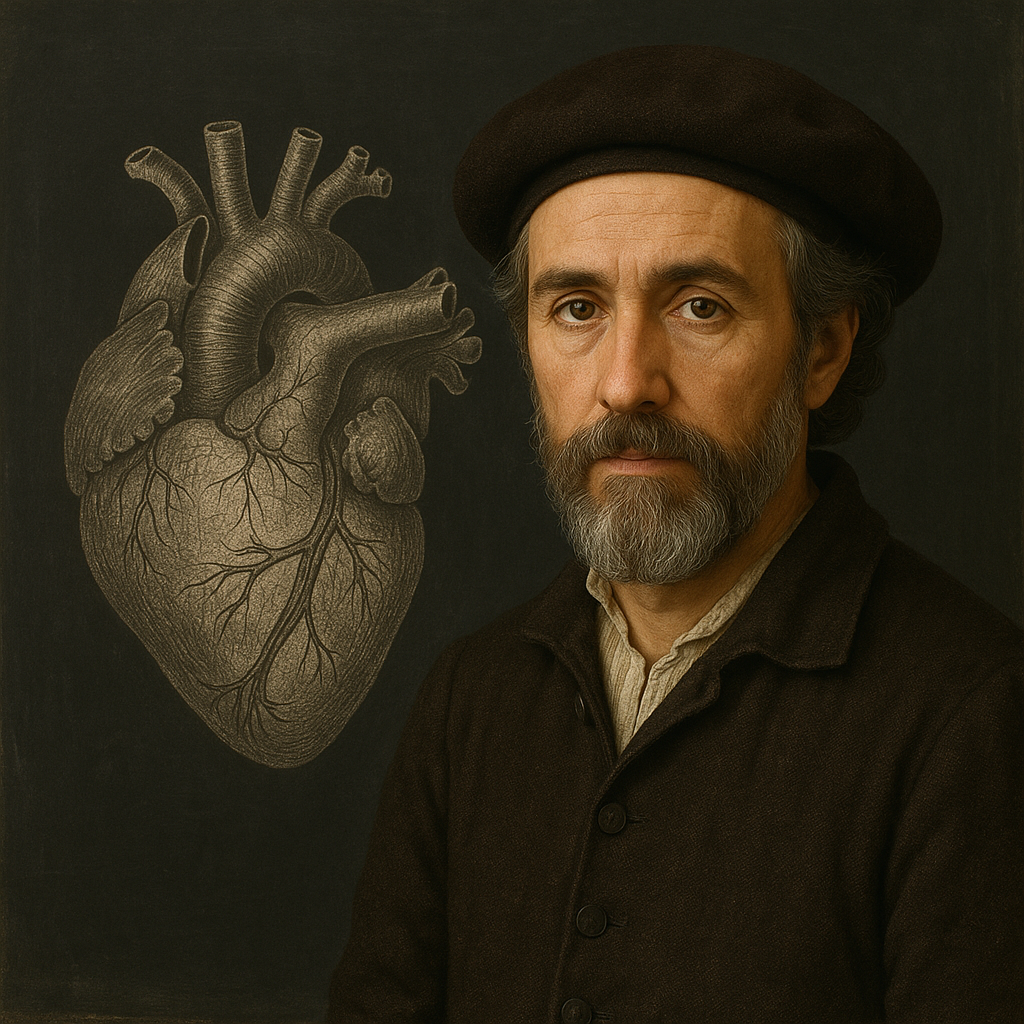
Miguel Servet: the Spanish visionary of cardiac circulation
Mike MunayShare
World Heart Day: Miguel Servet (Michael Servetus), the forgotten pioneer
Every September 29th, the entire world remembers the importance of taking care of the engine that keeps us alive: the heart.
In honor of World Heart Day, this week at Science Driven we'll be publishing a series of articles dedicated to this fascinating organ and everything it means for our health and our lives. Seven pieces will be added to our new category on the heart, now available in the blog menu.
And as if the calendar were winking at us, this September 29th brings together three unique dates: World Heart Day, the anniversary of the birth of Miguel Servet, the Spanish pioneer of physiology, and Saint Michael's Day. Three coincidences that seem like chance, but together they paint a perfect picture of science, history, and health.
I'll just give you a glimpse of Servet: he was a visionary who dared to look inside the human body and forever change what we thought we knew about blood and the heart. What he discovered cost him his life... and, at the same time, placed him in history as a forgotten pioneer who today beats stronger than ever.
Who was Michael Servetus?
On September 29, 1511, the feast day of Saint Michael, a child destined to trouble his time was born in Villanueva de Sigena (Huesca, Aragon, Spain): Miguel Servet. Neither a pure theologian nor a conventional physician, he always walked the frontier. Too much of a scientist for the religious leaders and too much of a theologian for the doctors, he never fit into the boxes of his century.
Between forbidden books and early mornings of study, he formulated an idea as simple as it was devastating: blood did not circulate as previously believed. That intuition, captured in his works, marked a turning point in the understanding of the human heart. But the price of looking too far ahead was high.
In 1553, after being persecuted for his ideas, Servetus was captured in Geneva and convicted of heresy by Calvin's court. The sentence was merciless: he was burned at the stake along with his books. On October 27, 1553, the smoke from his body and his pages mingled in the air, reducing to ashes a discovery that could have transformed medicine long before.
His contribution was silenced for decades, buried under the weight of censorship and fear. Only with the passage of time did history restore him to his rightful place: that of a pioneer who was ahead of his time and paid with his life for thinking too freely.
Servetus' contribution to science: pulmonary circulation
The medicine of his time was still following the teachings of Galen, the second-century Roman physician. According to his doctrine, blood originated in the liver and was consumed as fuel. It was believed that some of it filtered from the right ventricle to the left through supposedly "invisible pores" in the cardiac septum. No one had ever seen them, but everyone repeated them as an indisputable truth.
Miguel Servetus dared to contradict him. By observing and reasoning, he concluded that such pores simply did not exist. Instead, he proposed something radical for his time: blood from the right ventricle exited through the pulmonary artery to the lungs, where it was transformed by mixing with air, and returned to the heart through the pulmonary veins to the left ventricle. In other words, he described the pulmonary circulation, the circuit between the heart and lungs that we all take for granted today and that every student learns in their first medical school year.
Today, with MRIs, ultrasounds, and 3D models, that explanation seems almost obvious, a basic detail in any anatomy textbook. But in the 16th century, it was a true revolution: it effectively overthrew the Galenic doctrine that had dominated medicine for over a thousand years. Servetus wasn't just correcting an error; he was challenging an entire medical tradition that had become dogma.
When the world rediscovered Servetus
After the bonfire of 1553, silence.
For years, the name of Michael Servetus remained buried under the ashes of his bonfire. His medical work, written within a theological treatise ( Christianismi Restitutio ), was so suspect that only a few hidden copies ever circulated. Thus, his discovery of pulmonary circulation went almost unnoticed until 17th-century anatomists and physiologists began to compare sources and recognize that the Aragonese had been ahead of their time.
The publication of William Harvey's theory of the minor circulation in 1628 prompted some scholars to revisit earlier texts. It was then, when excerpts from Servetus's work were recovered, that it became clear that he had described the minor circulation many years earlier. Recognition, however, was slow: modern science accepted him, but the weight of his condemnation continued to cloud his memory.
In the 19th and 20th centuries, he went from being considered a cursed heretic to being hailed as a pioneer of physiology and a martyr of free thought. In Spain, after centuries of silence, his figure was incorporated into the pantheon of great names in medical history. Today, streets, busts, and, most notably, the Miguel Servet Hospital in Zaragoza honor his legacy.
From cursed heretic to scientific hero, Servetus' story is that of a visionary whose time failed to listen, but whom posterity eventually proved right, just as happened with Dr. Subhash Mukhopadhyay, the ill-treated Indian hero of in vitro fertilization, whom we have already discussed in a previous article .
Monuments and memory of Servetus
Servetus's influence is not limited to books. There are monuments in his honor in Zaragoza, Huesca, Villanueva de Sigena, Geneva, France, and the United States, in the form of statues, plaques in universities, hospitals, churches, parks, and even an asteroid bearing his name . Each of them represents the recovery of a figure who for a long time was uncomfortable to remember.
His tolerant spirit is reflected in one of his most quoted phrases:
“...I don't agree with either of these or those on every point, nor do I disagree. It seems to me that they all have some truth and some error, and that each sees the other's error, but no one sees their own... ”
A statement that places him not only as a scientific pioneer, but as a champion of tolerance and freedom of thought .
Reflection: A heart that beats beyond time
Every September 29th, the world pauses for a moment to remember the importance of caring for our hearts. On that same day, Miguel Servet was born, the man who dared to look inside his heart like no one else had before. His life ended in flames, but his discovery survived and is now part of the most basic knowledge of medicine.
World Heart Day wasn't marked in his honor, but the coincidence is almost poetic: while doctors and patients talk about prevention and healthy living, the echoes of that Aragonese man who forever changed the way we understand blood and life also resonate.
Remembering Servetus is remembering that science advances thanks to those who dare to challenge the established order. And that, sometimes, the strongest heartbeats are not those heard in life, but those that continue to resonate centuries later.

4 comments
MUY INTERESANTE EL ARTÍCULO! Y ALLÍ SE VE LA IGNORANCIA DE LA GENTE, QUE LO RODEABA! MATARLO POR DECIR UN GRAN DESCUBRIMIENTO!! QUÉ PENA!!
Me gustó mucho el artículo,sobretodo la delicadeza y la ternura con la que está hecho .Nunca tan bien dicho : me ha llegado al corazón . Gracias Miguel Servet
Me gustó mucho el artículo,sobretodo la delicadeza y la ternura con la que está hecho .Nunca tan bien dicho : me ha llegado al corazón . Gracias Miguel Servet
Excelente recordatorio para celebrar y cuidar nuestro CORAZÓN. Bravo chicos por tan interesantes artículos y muy necesarios de conocer y tomar conciencia de ellos👏👏👏💪❤️❣️👍👌